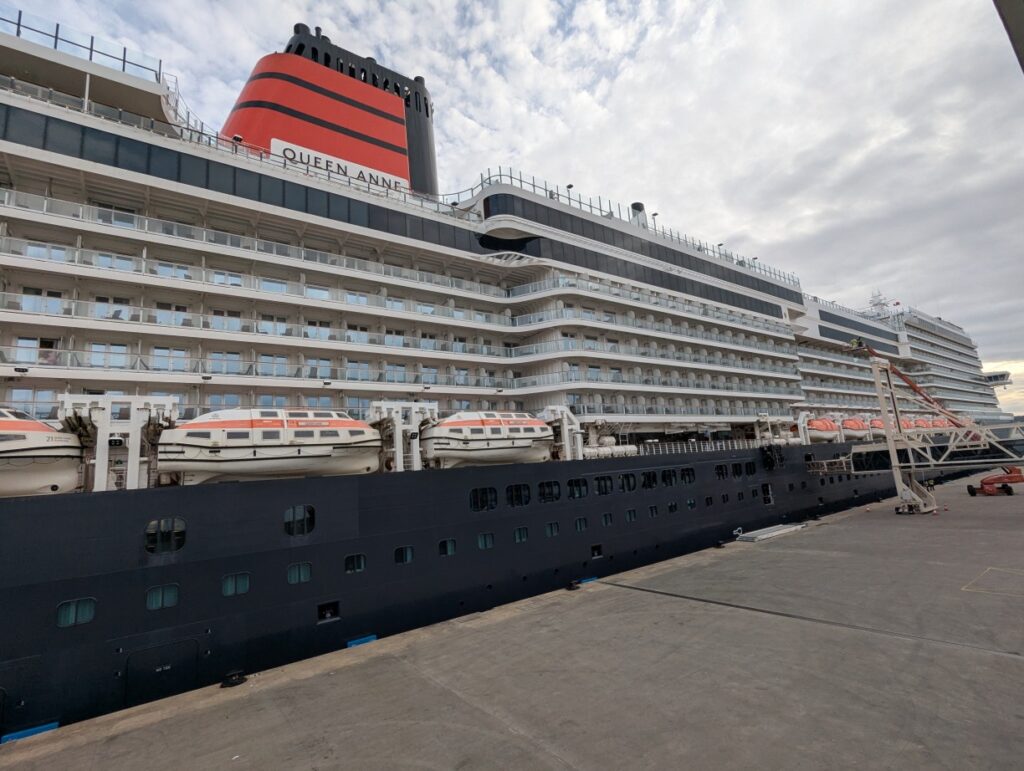
At the end of October 2025, my wife and I took a short cruise aboard the Cunard Queen Anne, visiting ports in Spain and Portugal. I’d intended to take a break from writing about wine, but I couldn’t resist putting together a few reflections and tips based on the experience.
Carnival, with the new ship Queen Anne, is targeting younger travellers by modernising the experience without ditching its heritage. Queen Anne shows this shift with contemporary dining concepts, livelier nightlife like the Bright Lights Society, casual venues, lighter design and wellness touches. Reports suggest more guests in their thirties and forties, indicating the strategy is drawing a younger crowd while keeping loyalists on board.
While the cruise overall was enjoyable, the wine by the glass offering left much to be desired. The bars around the ship had a very limited selection, although this did improve in the main dining venues. The ship clearly focuses on wine by the bottle, with a menu so extensive it’s more akin to a book. However, as was evident from our own habits and observing other guests, there is strong interest in by-the-glass options. It makes sense. Variety is crucial on cruises and a glass of wine presents far less financial commitment and risk than a full bottle.
One persistent issue, not just on this cruise but across many cruise lines, is the misuse of the term ‘Champagne’. It’s often applied to any sparkling wine offered during events, even when what’s poured is clearly not Champagne at all. Wine service was another weak point. In both public areas and the main dining room, it could be difficult to get served at all. On one occasion, at dinner, I had to leave the table to find a sommelier just to ensure a glass arrived before the second course. It seems that cruise lines, at the Cunard level, are cutting back on drinks service staff to reduce costs. There were also no wine-focused rooms/bars or dedicated wine events, which felt like a missed opportunity, particularly with three days at sea.
The ship’s own label wines, the ‘Cunard’ range, were mostly underwhelming, lacking both aroma and flavour. My advice would be to avoid these if you can and instead opt for branded wines. One couple we dined with had the inclusive premium drinks package at $90.00 per person per day, covering wines up to $20 a glass. It’s in dollars as the ship is owned by parent US company Carnival Corporation. They were baffled when the ship ran out of Whispering Angel rosé. They were told it would be available the next day, despite no port visits in the meantime. Whether this was rationing or some odd logistical issue, it highlighted how patchy the wine supply can be.
That said, there were a couple of highlights. The Framingham Sauvignon Blanc from New Zealand, priced at $14 a glass, was fresh and vibrant. And the Cunard Cellar Reserve Rioja Reserva from Bodegas Zugober at $17.50 a glass was excellent, flavoursome and well balanced.
All bar purchases attract a 15% service charge. Another gotcha, if your cruise sails from Spain, Spanish VAT (IVA) at 10% applies to drinks from the bar while the ship is in Spanish territorial waters. If your voyage both starts and ends in Spain and does not call at any non-EU ports, Cunard applies the 10% Spanish IVA throughout the entire cruise.
For those thinking ahead, a useful tip is that you’re allowed to bring a bottle of wine per person onboard on embarkation day to enjoy in your cabin. You can take it to dinner, but this comes with a $25 corkage fee. Considering the high markups on the wine list, this is well worth doing if you have a favourite wine or find something interesting ashore. If you bring on wine later, during the cruise, the ship usually holds it until your final night, or leaving the ship, unless you pay corkage. However, we’ve found that when security x-ray screening is handled by port authorities rather than the ship itself, bottles tend to pass through unnoticed. It’s worth observing where the incoming security checks take place when going off the ship for the day. If it’s port-run, it’s likely you will be able to bring wine back onboard without it being seized. We did exactly that on this trip, though we ended up keeping the wine to take home.
Interestingly, we found our previous wine experience on a P&O Cruise, also part of the Carnival group, to be far superior. It’s surprising given the shared ownership and suggests Cunard has some work to do in this area.
Also read about Sibarita, Rectoral de Amandi Mencía and Reguengos Reserva that we discovered ashore during the cruise.













